Near the end of November, we cannot help but look forward to the Christmas holiday which marks the celebration of the birth of the Lord Jesus Christ who is the Son of the living God, the Almighty Father of Lights who is the creator of the heavens and the earth. While we think about this extremely significant holiday, we must look at a Jewish holiday that starts around this time of year and that celebrates the restoration of the honor of the Almighty God who sanctified the Israelites as his sacred people. This holiday which is most common amongst the Jewish people but is celebrated in other cultures and especially in the United States is “Hanukkah”, otherwise known as “Chanukah.”
The word Hanukkah, “ḥanuká” in Hebrew, simply means “dedication” and refers specifically to the liberation and re-dedication of the Second Jewish Temple to the Lord God Almighty in the year of 165 B.C.. The history is interesting because it doesn’t just signify the liberation of the Jewish people so that they could freely worship the LORD but it directly signifies the re-dedication of the temple where the Jewish people were convinced that the Lord God met with the Israelites personally during every worship event. In the following paragraphs, we would love to give a little bit of information about Hanukkah – when and how it is celebrated and a little bit of its history.
Hanukkah is a Jewish festival that is also known as the Festival of Lights due to the fact that it is observed via the lighting of nine candles on what is called a candelabrum. The festival is celebrated for eight nights and days and starts on the eve of the 25th day of Kislev (Hebrew calendar) because a 24-hour Hebrew day starts at sunset. Via the Gregorian calendar which is the calendar type that we use in the East and West, the first day of this Festival of Lights starts typically towards the end of November or the end of December depending on the year. The festival is typically known for the lighting of this candelabrum of nine branches which is correctly called a menorah. One branch is typically placed in the middle of the menorah above or below the other eight branches, and the candle on the branch is used to light the other candles which are lit once every night of the festival. The eight nights and days are significant since as the story goes, the oil that burned during the re-dedication of the temple lasted for eight days – a miracle since the Israelites believed that they only had enough oil for one day.
One of the known rituals for Chanukah apart from the lighting of the menorah is a tradition called Ma'oz Tzur. During this tradition, especially in the Ashkenazi, the hymn by the name of “Ma'oz Tzur” is sung. The song is very interesting because it contains six stanzas – the first and last which is recognized for its themes of divine salvation and the middle four containing themes that reference the following: (1) the events of Jewish persecution throughout history, (2) praises to God for Jewish survival despite these tragedies, and (3) a longing for the moment in which Judea would finally triumph over Rome. After this song is sung, other significant songs are sung as well in devotion to the grace of God – songs such as the recitation of psalms in song (Psalms 30, 67, 91).
To give a little bit of history behind the celebration of Hanukkah. Judea belonged to the Ptolemaic Kingdom of Egypt until the year of 200 B.C. – the year that King Antiochus III the Great of Syria defeated King Ptolemy V Epiphanes of Egypt during the battle of Panium; Judea was transferred to the Seleucid Empire (Syria), but the King guaranteed the Jews the right to continue their ancestral customs of worship as a means of conciliation. After that transfer to a new empire, while the Jews were at peace, Antiochus IV Epiphanes who was the son of Antiochus III the Great invaded Judea during the year of 175 B.C. as a request of the sons of Tobias. The Tobiads who led the Hellenizing Jewish faction that was in Jerusalem were expelled to Syria in 170 B.C. when control was wrestled from them by a high priest, Onias, and his pro-Egyptian faction. As a result, the Tobiads lobbied Antiochus IV Epiphanes so that Jerusalem could be re-captured.
Judaism was outlawed by the time that the Second Temple in Jerusalem was looted and its services stopped; in 167 B.C., Antiochus IV Epiphanes constructed an alter in the Temple in honor of Zeus, the Greek God. Antiochus’ actions provoked a gran revolt – Mattathias (a Jewish priest) and his sons, Jochanan, Simeon, Eleazar, Jonathan, and Judah, led the revolt that found its successful end in 165 B.C. against the Seleucid monarchy. After the revolt, the Second Temple was liberated and re-dedicated to the Lord God Almighty. Judah ordered the cleansing of the Temple and a new altar was built in place of the polluted one and new holy vessels were made.

